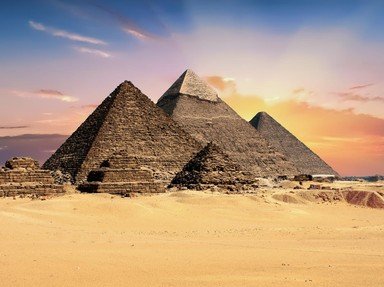Quiz Answer Key and Fun Facts
1. You are standing on the Giza plateau around the year 2450 BC. Your eyes travel over the vista where a vast stone structure is taking shape in the desert. Turning to the east and looking across the Nile in flood, what magnificent city do you see?
2. Pyramid building is still a growing science. An earlier pharaoh attempted the first true pyramid south of Giza. Disaster struck and the original 54 degree angle of the incline had to be changed to stop the structure from collapsing. What was the hastily adopted new angle?
3. You are confident that this project will succeed. Fifteen years ago your grandfather was present at the foundation ceremony. In order to determine astronomical north, the priests used the constellation Ursa Major (Big Dipper) and what other?
4. A few years ago, you arrived at Giza to haul stone. It was backbreaking work. Since that time, you've been promoted to overseer. You stride over to where your work gang strains to move one of the blocks. What is the block likely to weigh?
5. The work gang under your control consists of a hundred workers. You chose to call them 'The Gang of Excellence' to motivate them. The gang is divided into groups of twenty. The groups are known by what traditional terms?
6. Because the Nile is in flood and farmers cannot labour in their own fields for three months, they work on the pharaoh's building projects. What benefit does a farmer gain from doing this?
7. At a special treat, your wife packed you a lunch. As you sit down on a nearby outcrop of rock, you unpack the bread loaf, a handful of figs and a jar of barley beer. As you have a sweet tooth, what did she include to sweeten your meal with?
8. You notice your gang forcing a block into place. You shout angrily at them for not following the instructions painted on the stone. What might the marks read?
9. As guardian of the Giza plateau, the sphinx seems to watch your every move. It comforts you that the image of the sungod gazes down at you. Deciding to pace off its length from its rump to its paws, what is the length of one giant paw?
10. Close to the rising pyramid, workers are also digging boat pits. Actual boats are to be buried in them to ensure the pharaoh's journey to heaven. What wood was used to build the ships?
Source: Author
sterretjie101
This quiz was reviewed by FunTrivia editor
gtho4 before going online.
Any errors found in FunTrivia content are routinely corrected through our feedback system.
